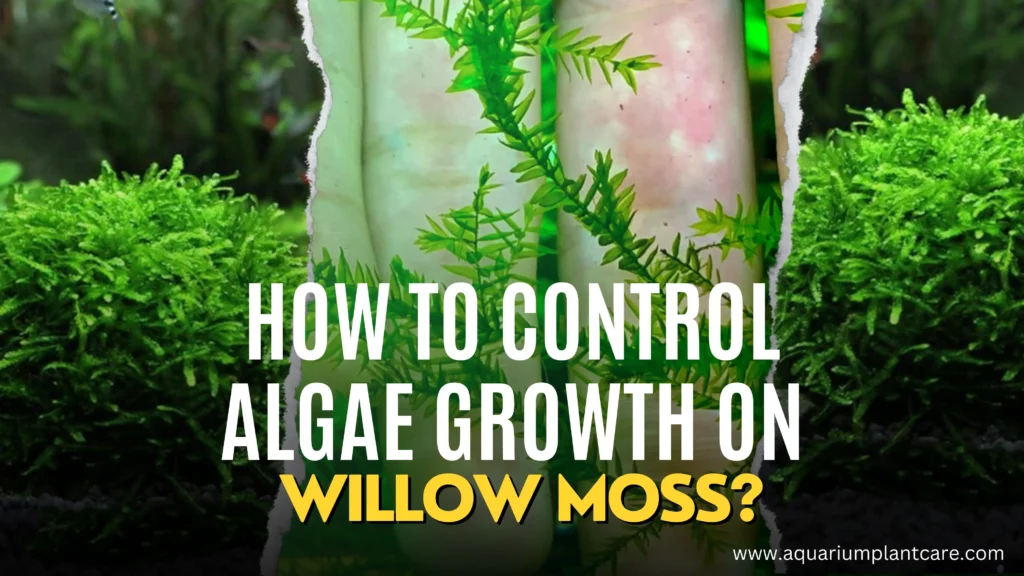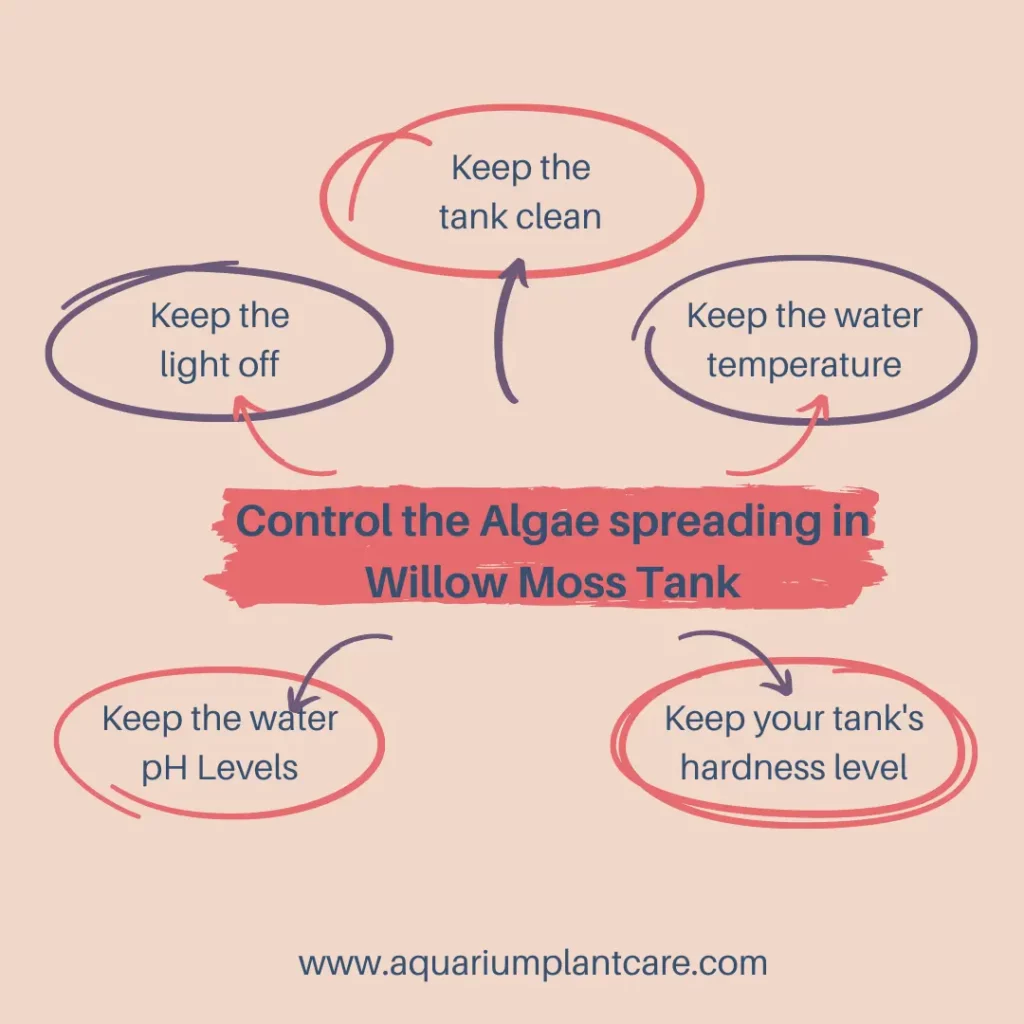Algae is a common problem in freshwater aquariums, but there are ways to control it. The first thing to do is determine where the algae came from.
Most often, algae will grow on rocks or other surfaces in the tank. This means that you need to find out what caused it and remove it from your tank before moving on with this article!
Table of Contents
- How to control Algae growth on Willow Moss?
- Where do algae come into Willow Moss Aquarium Tanks?
- How can I keep the Willow moss plant clean?
- How to Extract hair algae from Willow moss?
- Will Algae Kill Willow Moss in my Aquarium?
- Is Algae Toxic to Willow Moss?
- How to prevent from Algae spreading in Willow Moss Tank?
- How to clean algae without killing Willow Moss?
- What types of algae can grow in Willow Moss tanks?
- How to remove the algae from fake Willow Moss Plants?
- Can Hydrogen peroxide kill algae in Willow moss?
- Can Baking Soda kill algae in Willow Moss?
- How long does it take to kill algae from Willow Moss?
- Does Willow Moss eat Algae?
- Conclusion

How to control Algae growth on Willow Moss?
Here are some of the tips that you can follow to control Algae growth on Willow Moss.
- Use an aquarium net to remove algae from the plant
- Use an aquarium scraper to remove algae from the plant.
- Use an aquarium water conditioner to remove algae from the plant.
So, in order to control Algae growth on Willow Moss, you should use an aquarium net, aquarium scraper aquarium water conditioner. These things will help you to remove algae from the plant.
Where do algae come into Willow Moss Aquarium Tanks?
Algae can come from a number of sources, including the water source, aquarium owner and filter. You should also be aware that algae will grow in your tank if there is not enough light on your plants and decorations.
The most common source of algae growth is from the aquarium owner themselves. If you have an aquarium with clear water and no fish or other animals in it then this could be the reason why you are seeing algae growth in your tank.
The most common type of algae is called cyanobacteria which grows very quickly due to a lack of nutrients within its habitat (water).
How can I keep the Willow moss plant clean?
To keep your plant clean, use the following steps:
- Use a siphon to remove all the gunk that builds up on the plant. A siphon is a small tube used for draining, cleaning, and rinsing liquids or solids from one source to another. You can also use it to drain accumulated water from your aquarium.
- Wipe off any algae on your willow moss with a soft cloth or paper towel after each water change or if you have been away from home for a while (e.g., during vacation). If necessary, add some saltwater solution in order to remove any remaining green color from the leaves of this particular species of aquatic vegetation which has been grown in freshwater ponds since its inception as an ornamental aquatic grass species known as Alisma Plantago-Aquatica L.
How to Extract hair algae from Willow moss?
As you may know, Algae is a plant that lives in the water. Algae can form a thick mat on your tank and make your aquarium look dirty or slimy. Algae needs light and CO2 for growth; if these conditions aren’t met, it won’t grow either!
To remove algae from your willow mosses:
Remove any dead leaves floating in the bucket or tub of water. This can be done by hand with cotton swabs dipped in vinegar (1 tablespoon per cup), but you’ll need to get creative if there’s more than one leaf stuck together with mud at the bottom of your tank or bucket!
Try using tweezers if you don’t want to do this step manually you’ll probably only need one leaf at most anyway so try not taking too long doing this step every day until everything else has been removed from above ground level (this includes dead roots).
Remove any remaining algae still attached to stems/roots by pulling off stubborn pieces directly over top where they’re growing via tweezers or tongs (not cutting into them). You might also want some kind of brush handy like toothpicks so that those pesky little guys won’t escape before getting caught again later during cleaning time!
Will Algae Kill Willow Moss in my Aquarium?
Algae can kill Willow Moss in your aquarium. If you have a planted tank and have been experiencing algae problems, then it’s likely that algae is the problem.
The most common types of algae are green and brown algae, but there are others as well such as red or black algae. These kinds of algaes may be toxic to Willow Moss so it’s important to check with a professional before adding any plant species into your aquarium environment.
Is Algae Toxic to Willow Moss?
Algae is a type of plant that can be toxic to your willow moss. If you have algae growing on your willow, it’s time to clean it off!
Willow moss is one of the most popular types of plants used as substrates in aquariums and Koi ponds because it’s easy to care for and grow.
Remove debris and waste material from water using a siphon.
The best way to remove debris and waste material from water is through a siphon. A siphon is an instrument used for drawing liquids up through a tube or pipe, allowing you to draw out all the impurities that may have gotten into your aquarium.
You can purchase one at most hardware stores, or even make one yourself with common household materials like plastic tubing, aluminum foil, and rubber bands.
To use this tool:
Insert one end of the tube into the aquarium while holding onto the other end with both hands on either side of it (see image below). This will ensure that you don’t get trapped inside when trying to pull out anything else from inside!
How to prevent from Algae spreading in Willow Moss Tank?
Here are some of the tips that may help you to prevent from Algae spreading in Willow Moss Tank:

- Keep the tank clean
- Keep the light off
- Keep the water temperature at a consistent level
- Keep the water pH at a consistent level (pH should be around 6-7)
- Keep your tank’s hardness level consistent by adding more Calcium Chloride or Ammonium Sulfate to your water regularly
How to clean algae without killing Willow Moss?
First, you have to remove any debris that has settled on the leaves. You can do this by using a siphon.
Siphons are good for removing algae from the surface of your aquarium or pond, but they’re not very effective at removing algae from underneath the leaves of your willow moss (which is where most of it tends to grow).
To get rid of this kind of build-up, brush away any loose leaves and then use an algae magnet to pull out any residual pieces that still remain inside your aquarium or pond.
What types of algae can grow in Willow Moss tanks?
The following types of algae can grow in Willow Moss tanks:
- Green Algae
- Brown Algae
- Blue-green Algae
- Red Algae
- Yellow Algae
- Black Algae
Similarities between Algae and Willow Moss
Here are some of the similarities between Algae and Willow Moss:
- Algae are a kind of plant, Willow Moss is a kind of plant
- Algae grow in water, Willow Moss grows in water
- Algae are green, Willow Moss is green
How to remove the algae from fake Willow Moss Plants?
In order to remove the algae from fake Willow Moss Plants, you should use a soft cloth to remove the algae from the leaves of the plant.
Now, remove the algae from the leaf surface of the plant. After doing this step remove the algae from the leaves of the plant.
Can Hydrogen peroxide kill algae in Willow moss?
Yes, Hydrogen peroxide can kill algae in Willow moss. Hydrogen peroxide is not the best option to kill algae in Willow moss. There are a lot of other good options available to kill algae in Willow Moss.
Can Baking Soda kill algae in Willow Moss?
Yes, Baking Soda is a good Algae Cleaner. Moreover, Baking Soda is a natural product so it’s safe to use Baking Soda to kill algae in Willow Moss.
How long does it take to kill algae from Willow Moss?
The time it takes to kill algae from Willow Moss depends on how much algae is in the tank. Usually, it takes about 3-4 weeks to kill algae. You can also use a UV sterilizer to speed up the algae-killing process.
Does Willow Moss eat Algae?
Willow moss is not a plant that eats algae. That’s why you have to manually remove algae from the aquarium.
Conclusion
Algae is a common nuisance in a freshwater or saltwater aquarium. It can be difficult to remove, even when it is growing on your plants or inside the filter.
The best way to control algae growth is by keeping your water clean and well filtered at all times.
When there are still signs of algae in your tank after trying these methods, consider adding more nutrients like carbon dioxide or oxygen-rich air stones into the tank. This will help promote plant growth while helping keep algae away!
